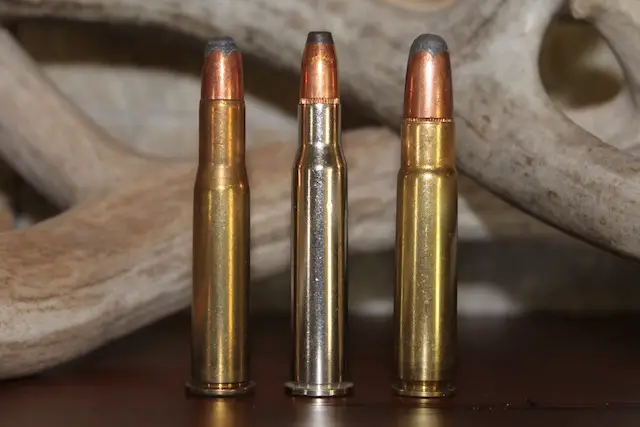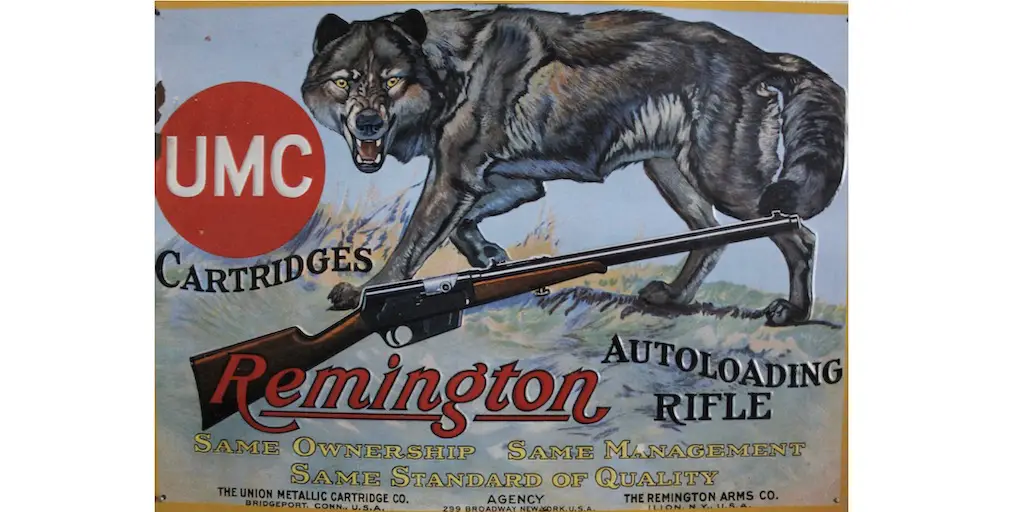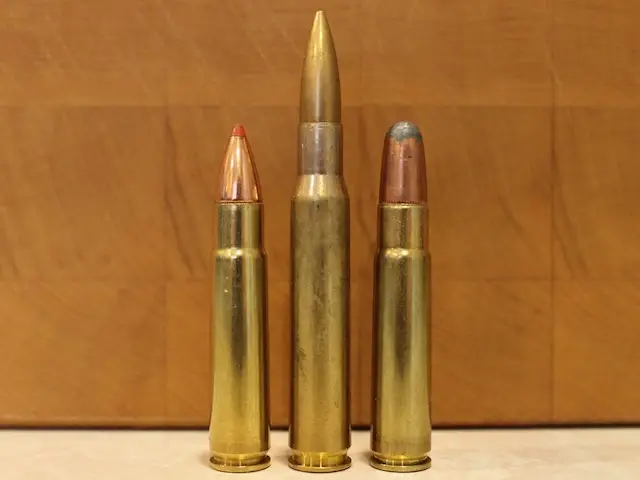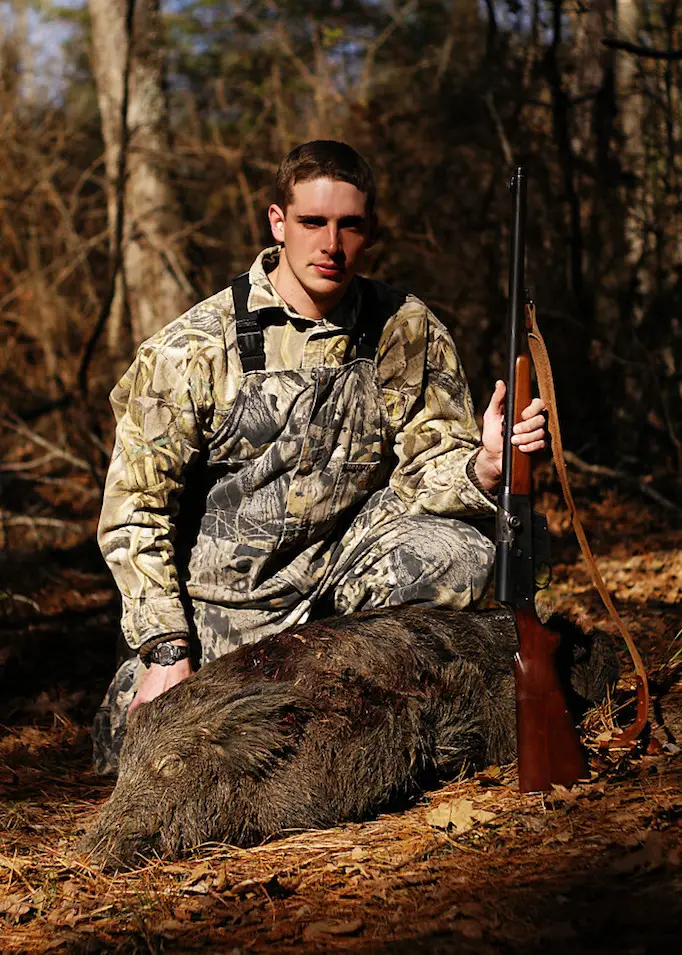.
While the .35 Remington was extremely popular when first introduced in the early 1900s, the cartridge has fallen out of mainstream use in recent years. A loyal segment of hunters and shooters still use the cartridge, but most other hunters pass by the .35 Remington in favor of modern cartridges with more impressive ballistics on paper.
In my opinion, that is a big mistake.
The .35 Remington initially found favor among hunters seeking a good “brush bullet” and many deer, bear, elk, and even moose have fallen to the .35 Remington over the years. Don’t be fooled by it’s somewhat anemic looking ballistics on paper when compared to newer cartridges sporting fancy pointed tips and blazing fast velocities.
Those same characteristics that made the .35 Remington such an effective choice on really large animals during the 20th Century still ring true today. It never has been and never will be a good long range cartridge, but if anything, modern loadings using high quality bullets have further improved the performance of the .35 Remington on big game at short to moderate range.
In this article, I’m going to conduct a detailed analysis of the .35 Remington in an effort to cut through some of the myths and misunderstandings out there regarding the capabilities of the cartridge so you can make an informed decision regarding whether or not you should hunt with one.
Before we get started, I have an administrative note: Some of the links below are affiliate links. This means I will earn a small commission (at no extra cost to you) if you make a purchase. This helps support the blog and allows me to continue to create free content that’s useful to hunters like yourself. Thanks for your support.
Additionally, I recorded an entire podcast episode on this exact subject. If you’d rather listen than read, click the appropriate link below to listen to this episode on your preferred podcasting service.
Be sure to hit that “Subscribe” button in your podcast player!
Subscribe
Apple | Google | iHeart | Pandora | Spotify
.35 Remington History
Remington introduced the Remington Auto-Loading Rifle (later known as the Remington Model 8) in 1906. Along with the rifle, they introduced four new rimless cartridges: the .25 Remington, the .30 Remington, the .32 Remington, and the .35 Remington.
Of the four rifle cartridges introduced with the Remington Model 8, the .35 Remington was by far the most popular and is the only one still in production.
.35 Remington Ballistics
Since it had no competitor at the time, and since it filled an important “medium bore” niche, the .35 Remington quickly caught on with hunters in the United States. The original load of the cartridge propelled a 200 grain, .35 caliber, bullet at just under 2,100 feet per second.
The original .35 Remington load generated over 1,900 foot pounds of energy and quickly became a favorite among American hunters.
Particularly when used in a high quality rifle, the .35 Remington is capable of pretty darn good accuracy and I’ve shot many nice groups with an off the shelf Remington Model 81. However, the biggest shortcoming in the cartridge is limited effective range.
Even when using loads on the upper end of the performance envelope for the cartridge, the .35 Remington still has a relatively slow velocity and low ballistic coefficient. As a result, the cartridge does not have a very flat trajectory.
Realistically, the maximum effective range for the .35 Remington for most shooters is 200 yards. Depending on the load, 150 yards may be a better estimate.
So, in recognition of both the strengths and weaknesses of the cartridge, the .35 Remington gained a good reputation among American hunters seeking an effective “woods cartridge” for pursuing game in areas where shots inside 100 yards were the norm.
The .35 Remington was extremely effective in that role.
Remington marketed the cartridge as a superior alternative to another extremely popular cartridge that excelled under those same circumstances: the venerable .30-30 Winchester.
35 Remington vs 30-30
A typical 35 Remington factory load (200gr bullet at 2,080fps) has about 5% more energy than a normal 30-30 factory load (170gr bullet at 2,200fps). The 35 Remington also uses a bullet about 18% heavier and with over 35% more frontal surface area (.1007 vs .0745 square inches).
These seemingly small differences added up to a significant difference in power and effectiveness on game between the two cartridges. In particular, the .35 Remington offers a marked advantage over the .30-30 Winchester when hunting very large, tough, and/or dangerous game like moose and grizzly bear.

Remington made great efforts to promote the power of the .35 Remington by featuring the cartridge, along with their revolutionary new semi-automatic rifle, in many advertisements during the first half of the 20th Century. These advertisements typically featured hunters fearlessly facing down wolves and grizzly bears with their trusty Remington Auto-Loading Rifle chambered in the potent .35 Remington cartridge.

Other Remington posters publicized the ability of the cartridge to penetrate a 5/16″ of steel plate, a feat the .30-30 Winchester could not match.
.35 Remington Ammo
Remington, Winchester, Federal, Hornady, and Buffalo Bore, among others, currently offer a handful of different .35 Remington ammo options. The most common load is a 200gr round nose soft point traveling between 2,000 and 2,100 feet per second.
For those interested in wringing out all of the power available in the .35 Remington, there are a couple of other .35 Remington ammunition options besides the standard 200gr soft point loads listed above. For instance, Remington also sells 150gr load that produces velocities around 2,300 feet per second.
Hornady also produces their “LEVERevolution” line of ammunition, which uses their Flex Tip Expanding (FTX) bullet. The FTX bullet has a pointed, flexible, polymer tip that has a higher ballistic coefficient than the flat tipped or round nose bullets the cartridge normally uses.
LEVERevolution bullets, unlike most bullets with pointed tips, are also safe to use in rifles that have tubular magazines (like the Marlin 336). The 200 grain bullet has an advertised muzzle velocity of 2,225 feet per second and a muzzle energy of 2,198 foot pounds.
Buffalo Bore also produces 220gr loads that they claim reach a velocity of 2,200 feet per second (2,364 foot pounds).
This is a very stout load for the .35 Remington.
Both of these .35 Remington ammo choices offer slight improvements over typical factory loads. However, they are high pressure loads and should only be used in modern firearms, such as the Marlin 336, that are in good condition.
BUY SOME MORE QUALITY 35 REM AMMO HERE

.35 Remington Rifles
In addition to the semi-auto Remington Model 8 and 81, Remington also produced the Model 14 pump-action rifle chambered in the cartridge. A very small number of Winchester’s legendary bolt-action pre-64 Model 70 rifles were manufactured in .35 Remington as well.
Thompson Center also manufactures their break action, single shot Contender pistol in .35 Remington for handgun hunters who love the cartridge. Henry Repeating Arms currently manufactures a model in .35 Remington as well.
However, the most popular rifle chambered in .35 Remington is the Marlin Model 336 lever-action rifle.
At this time, Henry and Marlin are the only two companies I’m aware of that produce new rifles in the cartridge.
BUY A NICE 35 REMINGTON RIFLE HERE
What Can You Hunt Using The .35 Remington?
Even when using the standard factory loads, the .35 Remington is an outstanding round for use on medium sized game such as whitetail deer, feral hogs, and black bear at short ranges. At ranges less than 100 yards, like when hunting whitetail deer or black bear in thick cover, the cartridge excels and is absolutely deadly on big game.
The heavy, slow moving bullets deliver bone crushing power and do not produce large amounts of ruined, blood shot meat that high velocity cartridges do. Additionally, the .35 Remington will perform adequately on larger game such as elk, grizzly bear, brown bear and moose.
It’s even more effective when using some of the hotter loads (like those from Buffalo Bore) available on the market.
Especially when used in handy, quick pointing rifles such as the Marlin 336, the .35 Remington really comes into its own when used in thick cover. For this reason, the .35 Remington is most popular in the northeast and southeast regions of the United States where shooting ranges are short.
When hunters there really need to make a rapid shot and anchor their game quickly, they can rely on a Marlin 336 chambered in .35 Remington. Because of its power and versatility, many generations of hunters from states as varied as Maine, North Carolina, Texas, and Georgia have successfully hunted deer, moose, bear, and hogs (like the one in the photo below) with the .35 Remington.
For a more detailed discussion on .35 Remington hunting ammunition, read this article:
Best .35 Remington Ammo For Hunting Deer, Bear & Other Big Game

Another interesting tidbit about the .35 Remington is the alleged use of a Remington Model 8 chambered in the cartridge by legendary Texas Ranger Frank Hamer in the final ambush that killed Bonnie & Clyde in 1934. However, historians are conflicted on the subject and there are several different stories about what rifle Hamer actually used.
We’ll probably never really know for sure, but it is certainly possible that he used a Remington Model 8 in the famous shootout, though it very likely did not have an extended magazine (as alleged by some sources).
Even though it does not sport the sexy pointed bullets and high velocities of some of the more popular cartridges on the market today, the .35 Remington still maintains a healthy following among American hunters. It is true that the cartridge has its limitations, but used under the right circumstances, it is an outstanding choice. If we’re being honest with ourselves, the majority of American hunters, especially in the south and northeast, will take only a handful of shots at big game at ranges past 100 yards in their lifetime. For those close range shots, the trusty old .35 Remington has few equals.
Are you just itching to take a rifle chambered in .35 Remington on a hunt?
Book an incredible black bear hunt here.
Book an outstanding African safari hunt here.
If you’d like to read a more detailed discussion on a couple of other .35 caliber cartridges, read the articles below:
338 Federal vs 308 Winchester vs 358 Winchester: What You Need To Know
35 Whelen: The Poor Man’s Magnum
America’s “Other Levergun” by Glen E. Fryxell, The Great Model 8 & 81 by Richard Jones, Bullet Frontal Area List, by Chuck Hawks, and the Lyman 50th Edition (p309-310) and Hornady 10th Edition (p682-683) reloading manuals were used as references for this article.
Enjoy this article on the .35 Remington? Please share it with your friends on Facebook and Twitter.
Make sure you follow The Big Game Hunting Blog on Facebook, Instagram, Twitter, and YouTube.
NEXT: 30-30 vs 45-70 WHICH LEVER ACTION IS BEST FOR YOU TO HUNT WITH?
NEXT: THE 9.3x62mm MAUSER: AN UNDERRATED BIG GAME HUNTING CARTRIDGE CARTRIDGE
NEXT: 101 BEST GIFTS FOR HUNTERS
John McAdams is a proficient blogger, experienced shooter, and long time hunter who has pursued big game in 8 different countries on 3 separate continents. John graduated from the United States Military Academy at West Point and is a veteran of combat tours with the US Army in Iraq & Afghanistan. In addition to founding and writing for The Big Game Hunting Blog, John has written for outdoor publications like Bear Hunting Magazine, The Texas State Rifle Association newsletter, Texas Wildlife Magazine, & Wide Open Spaces. Learn more about John here, read some of John’s most popular articles, and be sure to subscribe to his show: the Big Game Hunting Podcast.



Recently inherited my Dad’s 1950 336 in .35. It was also my grandfather’s. I will never sell it, thanks for the great article.
Glad you enjoyed it Gene! Thanks for your comment!
John
Great article! I have a complete set of Browning Blr from the 22 bl all the way to the 300 mag. I was trying to decide what to use for bear this season. I’ve owned a Marlin 336 in the 35 caliber for 40 years and have downed every large game shot at. I kept it at 100 yard max! This article has helped me decide to use old faithful over the 40 guns I own! Thank you for the lesson again after 40 years!
My Dad bought a .35 Marlin 336 for each of his (3) sons for our first deer gun. I’m the oldest at 54. Mine was bought at a Woolworths back in 1979. I have downed many whitetails with 20o grain Remi Core-Lokt and a 4x scope; running shots, 100 yard shots – all deer, over 30, have dropped in their tracks. Recently, I feel the Core-Lokt has slipped in quality and I switched to Hornady ( I didn’t want to as I’ve always had such luck with Core-Lokt ).
I would never sell this gun. I use it as my primary gun and it’s never let me down. One day my son will have it…
I own two Marlins chambered in .35. One an ADL Deluxe 1957 model and a Maurader RC 1963 model. Both have taken many Tennessee whitetail. My son and I argue who will take the RC on opening day being we both love it so much. My dad had a .35 Marlin in the 70’s but got traded for a 270. I had another in the 80’s and also got traded. Wish I had both of them back. Regardless, the .35 is my favorite.
Just got a nice 6-pointer with my Marlin 336 in .35 Remington. 200gr. Hornady round nose. He went down hard.
My dad was born and raised in Maine then we moved to North Carolina when I was two. The 336 Marlin in .35 Remington the 1970 anniversary model was the only deer rifle he owed. I have that gun now along with a 336 Marlin .35 of my own that I bought at a young age. I don’t know how many deer have been killed with these two guns but it has been many. The .35 is definitely a brush gun as my dad always called it and all around deer rifle with the 200 grain Core -Lokt.